
A birch is a thin-leaved deciduous hardwood tree of the genus Betula, in the family Betulaceae, which also includes alders, hazels, and hornbeams. It is closely related to the beech-oak family Fagaceae. The genus Betula contains 30 to 60 known taxa of which 11 are on the IUCN 2011 Red List of Threatened Species. They are a typically rather short-lived pioneer species widespread in the Northern Hemisphere, particularly in northern areas of temperate climates and in boreal climates.

Stigmella confusella is a moth of the family Nepticulidae. It is found from Fennoscandia to the Pyrenees, Alps and Bulgaria and from Ireland to central Russia.
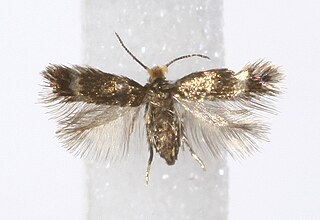
Stigmella betulicola is a moth of the family Nepticulidae. It is found in most of Europe, east to the eastern part of the Palearctic realm.

Stigmella lapponica is a moth of the family Nepticulidae found in Asia, Europe and North America. It was first described by the German entomologist, Maximilian Ferdinand Wocke in 1862. The larvae mine the leaves of birch.
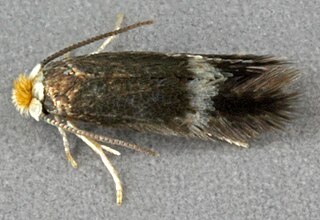
Stigmella sakhalinella is a moth of the family Nepticulidae. It is found from Scandinavia to the Pyrenees, Italy and Serbia, and from Great Britain to central Russia, east to the eastern part of the Palearctic realm. It is also found in the Near East.

Stigmella continuella is a moth of the family Nepticulidae. It is found from Fennoscandia to the Pyrenees, Alps and Hungary, and from Ireland to central Russia and Ukraine, east to the eastern part of the Palearctic realm.

Stigmella luteella is a moth of the family Nepticulidae. It is found in all of Europe, except the Iberian Peninsula and the Balkan Peninsula.

Ectoedemia occultella, the small birch leafminer, is a moth of the family Nepticulidae. It has a Holarctic distribution. It is found in most of Europe, east through Russia to Japan. It is also present in North America. Mines very similar to that of Ectoedemia occultella have been found on Rosaceae species in Nepal and Japan and these may belong to this species.

Roeslerstammia erxlebella is a moth of the family Yponomeutidae. It is found in all of Europe, east to Japan.

Lyonetia prunifoliella is a moth in the family Lyonetiidae.
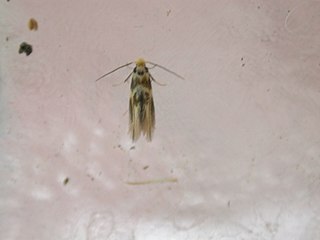
Bucculatrix thoracella, the lime bent-wing, is species of moth in the family Bucculatricidae, and was first described in 1794 by Carl Peter Thunberg as Tinea thoracella. It is found throughout Europe with exception of Ireland and the Balkan Peninsula, and in Japan, where it occurs on the islands of Hokkaido and Honshu.
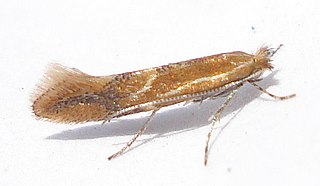
The hawthorn red midget moth is a moth of the family Gracillariidae. It is found in all of Europe.
Phyllonorycter anderidae is a moth of the family Gracillariidae. The species was first described by W. H. B. Fletcher in 1885. It is found from Fennoscandia and northern Russia to Belgium, Austria and Ukraine and from Great Britain to southern Russia.
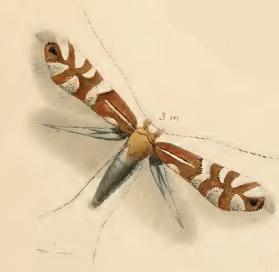
Phyllonorycter ulmifoliella is a moth of the family Gracillariidae. It is found in all of Europe, east to Russia and Japan.

Parornix betulae is a moth of the family Gracillariidae. It is known from all of Europe, east to Korea. It was recently reported from Canada, with records from Québec, Ontario and British Columbia.

Caloptilia betulicola, the red birch slender, is a moth of the family Gracillariidae. It is found from Scandinavia and the north of European Russia to the Pyrenees and Alps and from Ireland to Poland and Slovakia. In the east it is found up to China, Japan and the Russian Far East.
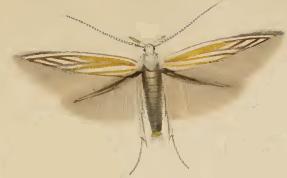
Coleophora currucipennella is a moth of the family Coleophoridae found in Europe. It was first described by Philipp Christoph Zeller in 1839.

Bucculatrix demaryella is a moth of the family Bucculatricidae. The species was first described by Philogène Auguste Joseph Duponchel in 1840. It is found in most of Europe, Russia and Japan.
Udea inquinatalis is a species of moth in the family Crambidae. The species was first described by Friederike Lienig and Philipp Christoph Zeller in 1846. It is found in most of Europe and North America.

Synanthedon scoliaeformis, the Welsh clearwing, is a moth of the family Sesiidae. It is found from almost all of Europe, east through Russia to Japan.
This page is based on this
Wikipedia article Text is available under the
CC BY-SA 4.0 license; additional terms may apply.
Images, videos and audio are available under their respective licenses.













